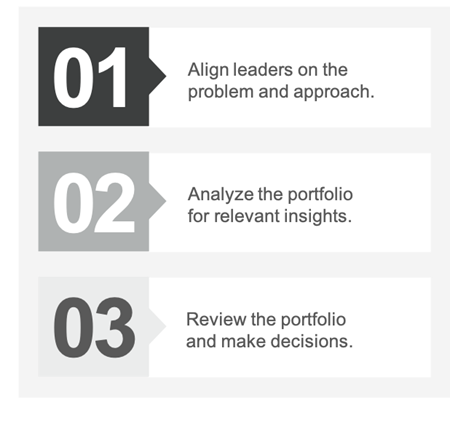In Brief
An organizational system of innovation is a critical differentiator in today’s market. The unpredictability of the market can force leaders to rethink their strategies, reassess investments and make urgent, often dramatic decisions about the future of their business. In times of rapid market change, a strong innovation system that is managed as an integrated portfolio (vs. individual projects) can help organizations achieve desired performance outcomes and drive growth.
To strategically prioritize innovation projects, leaders should regularly conduct portfolio reviews by following this three-step process:
Step 1: Align Leaders on Problem and Approach
For a strategic portfolio review to result in consequential decisions, the top leadership team must be committed and engaged. This means they must first agree on why they are undertaking the review and how decisions will be made.
First, leaders must define the problem — the performance objectives that your innovation portfolio is trying to solve (e.g., more revenue five years from now or reduced costs next year). There are many reasons an organization might decide to reevaluate its innovation portfolio. For most, it is a powerful way to assess if the organization is on track to meet its growth and other strategic goals.
Second, leaders should align on an approach for assessing the portfolio (e.g., the level of rigor, the time frame for analysis, the attributes of the target portfolio, the expected decisions to make as a result of the analysis).
Often, companies expect a portion of their growth to come from existing businesses, then look to innovation to fill any remaining “growth gaps” relative to long-term aspirations. A careful examination of the portfolio can highlight deficiencies and lead to resource allocation decisions that make achieving these goals more likely.
Step 2: Analyze the Portfolio for Insights
To maintain momentum around enterprise innovation, executives should regularly review their current innovation bets by asking three questions:
- Are we doing too much, too little or the right amount of innovation?
- Are we doing the right kinds of innovation?
- Have we optimized how resources are allocated to innovation?
Using the insights from these questions can unlock enormous near-term value from identifying projects that are no longer strategic, that focus on opportunities that are limited in scale or that are stalled for so long that chances of success are low. This type of analysis often reveals a hefty proportion of the organization’s total innovation spend that can (and should) be reallocated to higher-impact initiatives.
For such a review to be effective, leaders must think beyond business as usual by visualizing the portfolio from different perspectives to uncover actionable insights. Such portfolio views allow leaders to make immediate, no-regrets decisions about projects to stop or put on hold as well as those that should be accelerated or launched.
Leaders should next analyze the portfolio and develop the “portfolio views” necessary to support the relevant decisions agreed upon in step one. While leaders may not carry out the actual analysis, they have an essential role to play in guiding the process.
Projects with longer-term payoffs will naturally be reviewed critically in times of great change, as it’s common for companies to be spending too much on long-term opportunities relative to an urgent, short-term performance gap. This is often the case when market conditions have changed so dramatically that near-term growth expectations are radically reset and much of the previous innovation spend is no longer needed or aligned with the new reality. However, this can be taken too far and result in a portfolio that is too focused on the short term. This is another reason having these big-picture views of the full portfolio is so important, as it enables leaders to have a balanced discussion about short- versus long-term needs.
Step 3: Review the Portfolio and Make Decisions
The final step is to conduct a portfolio review workshop, during which leaders should push to make concrete decisions leading to actions that reset and strengthen the portfolio. The most important decisions will be about:
- Which projects to launch to fill gaps or better balance the portfolio.
- Which projects to continue and how to accelerate or strengthen important projects.
- Which projects to stop or put on hold to free up resources.
This exercise is often the first time a leadership team will get a comprehensive view of the total portfolio and derive critical insights as to how to strengthen it. It is quite common for many innovation projects that were inadvertently unfolding “undercover” to be revealed to the full leadership team for the first time in such a review.
Portfolio reviews are a powerful management tool to incorporate into the ongoing cadence of business conversations, as they enable leaders to ask better questions, have higher-quality discussions and make smarter decisions about their innovation systems. The real value in portfolio management comes from integrating portfolio reviews with quarterly business planning to ensure leaders are making regular informed decisions about how best to invest to drive growth.

